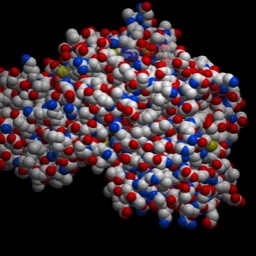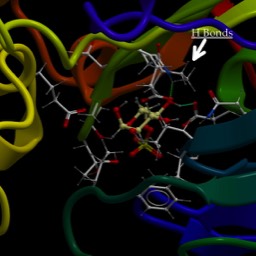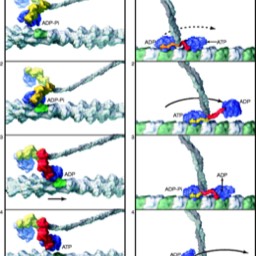Endocrine Signaling
Here is a link to the slides related to this.
Hormone: the signaling molecule
Gland (endocrine gland means "no ducts." Secrete around cells, distribute through the bloodstream)
Steroid hormone: kind of a special case. Does not have a receptor on the surface of the target cell. Carried through the blood bound to special carrier proteins and diffuses through the membrane of the target cell. The receptor is a transcription factor.
Homeostasis: This is the central point of the endocrine system. Keep things right about where they are. The system has evolved signals and counter signals that push back and forth against each other to keep things right about where they should be (or, at least, where they are).
Don't memorize lots of glands and hormones. The key points are:
The brain is the central controller for the endocrine system. The main units are the hypothalamus, which secretes many important hormones and the pituitary, connected to the Hypothalamus. It stores and secretes hormones from the hypothalamus as well as making its own. The other gland is the pineal gland, also in the brain, which mainly controls sleep (makes the hormone melatonin).
Many of the hormones of the hypothalamus and pituitary are "tropic hormones," which target other endocrine glands. They have names like "Thyroid Stimulating Hormone" (guess what that does).
Hormones are released to have an effect on target cells throughout the body. Target cells have receptors for the hormones. Not all cells react to the same hormone the same way. This may be because the different cells have different receptors. It may be because they have different signaling pathways connected to the receptor.
None of this is surprising in light of what you already know. Each cell has a limited set of things it can do…let's call them programs or subroutines. The hormone epinephrine binds to a receptor and the target cell runs it's "epinephrine routine." That routine is different in different cells.
Hormone signals interact both directly and indirectly. Two hormones may exactly counteract each other's signal (like glucagon and insulin) achieving homeostasis by the "yin and yang" of their functions. Also, hormone signals may modulate each other more indirectly. The effect of hormone "A" and "B" together may not be the sum of their individual actions, but instead combine to a new overall effect.
Homeostasis: With one or two notable exceptions (oxytocin being the main one) everything in this system is evolved to keep the status quo. I will include a figure on the test that talks about a system I haven't shown you before. You will have to read and interpret the figure.
The typical negative feedback system is where there is a signal, target cells respond, send a signal back to the origin of the first signal saying "I heard you, got it under control," and diminishes the original signal.
The rare positive feedback works differently. The target organ sends the signal "I heard you, give me more!" and things move off in a dramatic direction.
It might be interesting to think about "bad" examples of this. Depression can have a rather unpleasant "positive" feedback (positive is in quotes because the effects are "negative" with respect to health). The behaviors associated with depression are also behaviors that exacerbate depression.
Review
Terms:
Hormone: the signaling molecule
Gland (endocrine gland means "no ducts." Secrete around cells, distribute through the bloodstream)
Steroid hormone: kind of a special case. Does not have a receptor on the surface of the target cell. Carried through the blood bound to special carrier proteins and diffuses through the membrane of the target cell. The receptor is a transcription factor.
Homeostasis: This is the central point of the endocrine system. Keep things right about where they are. The system has evolved signals and counter signals that push back and forth against each other to keep things right about where they should be (or, at least, where they are).
General Outline
Don't memorize lots of glands and hormones. The key points are:
The brain is the central controller for the endocrine system. The main units are the hypothalamus, which secretes many important hormones and the pituitary, connected to the Hypothalamus. It stores and secretes hormones from the hypothalamus as well as making its own. The other gland is the pineal gland, also in the brain, which mainly controls sleep (makes the hormone melatonin).
Many of the hormones of the hypothalamus and pituitary are "tropic hormones," which target other endocrine glands. They have names like "Thyroid Stimulating Hormone" (guess what that does).
Neuro-endocrinology:
There are few distinctions between nervous system signaling except for the distance and speed of action (possible exception of steroids, as mentioned above). Many of the same mechanisms are involved and the two directly interact with each other. In fact, neurons can directly impinge on endocrine glands to cause them to release hormones. Many hormones are similar to or even identical to neurotransmitters. The mechanism of release is the same as we have seen before.Hormones are released to have an effect on target cells throughout the body. Target cells have receptors for the hormones. Not all cells react to the same hormone the same way. This may be because the different cells have different receptors. It may be because they have different signaling pathways connected to the receptor.
None of this is surprising in light of what you already know. Each cell has a limited set of things it can do…let's call them programs or subroutines. The hormone epinephrine binds to a receptor and the target cell runs it's "epinephrine routine." That routine is different in different cells.
Hormone signals interact both directly and indirectly. Two hormones may exactly counteract each other's signal (like glucagon and insulin) achieving homeostasis by the "yin and yang" of their functions. Also, hormone signals may modulate each other more indirectly. The effect of hormone "A" and "B" together may not be the sum of their individual actions, but instead combine to a new overall effect.
Homeostasis: With one or two notable exceptions (oxytocin being the main one) everything in this system is evolved to keep the status quo. I will include a figure on the test that talks about a system I haven't shown you before. You will have to read and interpret the figure.
The typical negative feedback system is where there is a signal, target cells respond, send a signal back to the origin of the first signal saying "I heard you, got it under control," and diminishes the original signal.
The rare positive feedback works differently. The target organ sends the signal "I heard you, give me more!" and things move off in a dramatic direction.
It might be interesting to think about "bad" examples of this. Depression can have a rather unpleasant "positive" feedback (positive is in quotes because the effects are "negative" with respect to health). The behaviors associated with depression are also behaviors that exacerbate depression.




